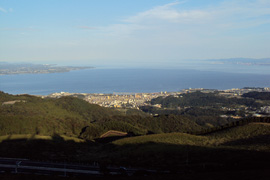The Mitsui & Co. Environment Fund
Introduction to Grant Projects
Faculty of Environmental Earth Science, Graduate School of Environmental Science, Hokkaido University Associate Professor Masanobu Yamamoto
Climatic fluctuations on a 10 year scale based on core samples from Beppu Bay; revealing the history of regime shifts
Research grant
- Project Description
A regime shift is a change in the basic structure of an atmosphere, sea or marine environment that occurs on a scale of several decades. With regards to the Pacific Ocean, this can be observed as periodic fluctuations in such pelagic resources as Japanese pilchard, anchovy, pacific herring, and trout. Since the 1990s, efforts have been advanced to 10-year (or 20- of 50-year) climatic cycling. To detect a 10-year cyclic signal, we need several hundred years of records. As observational records only go back 100 years or so, this acts as a serious obstacle. Long awaited to overcome it has been some proxy for a paleoclimatological record, such as sea bottom sediment samples. Also, as the issue of global warming gains prominence in recent years, we need to better understand the relation between regime shifts and climate modes so as to predict how marine resources will fare in the future; and, for this, it is desirable to reveal the pattern of regime shifting with regards to long-term (100- to 1,000-year) climatic fluctuations. In this research, we analyze core samples taken from Beppu Bay. By this, we reconstruct water-temperature/herring-population patterns for the last 2,300 years, comparing our results against 100-/1,000-year climatic fluctuations to learn if 10-year fluctuations and regime shifting has changed over that time.
- Fields
- Climate change
- Grant year
- FY2009 Research Grants
- Grant term
- 3 years
April 2010 - March 2013
- Grant amount
- 19,044,000 yen
- Activity region
- Beppu Bay, Oita Prefecture, Japan

Overview of the Organization

- Representative
- Associate Professor Masanobu Yamamoto
- Profile
- Specialist fields
Paleoclimatology, paleoceanography, organic geochemistry
Affiliated academic societies
The Geological Society of Japan; the Geochemical Society of Japan; the Japanese Association of Organic Geochemists; Japan Association for Quaternary Research; Japanese Association for Petroleum Technology; the Sedimentological Society of Japan; American Geophysical Union; European Association of Organic Geochemistry
Background
Completed a Master program in 1988 from Graduate School of Science, Tohoku University and in 1988 became a researcher at the Geological Survey of Japan, National Institute of Advanced Industrial Science and Technology. In 2000 took a position of Associate Professor at the Graduate School of Environmental Earth Science, Hokkaido University. In 2007 became an Associate Professor at the same institution. From 1993-1994 was a visiting scientist at Netherlands Institute for Sea Research, and i 1995 received a Ph.D. (science) from Nagoya University. From 1996-2000 became an associate Professor at the Graduate School of Science, Tohoku University - Collaborating researchers
- Michinobu KUWAE, Senior Researcher, Aichi University; Keiji TAKEMURA, Professor, Kyoto University
- Research record
- Research on petroleum genesis
- Development of ancient climate indices
- Research on long-term (100-year or more) climate shifts
-
- (1) Geochemistry lectures, (Vol. 4), Organic Geochemistry, Baifukan Co.(2004)
- (2) The 1,500-year climate oscillation in the mid-latitude North Pacific during the Holocene. Geology, 37, 591-594 (2009)
- (3) Changes in terrestrial organic matter input to the Mendeleev Ridge, western Arctic Ocean, during the Late Quaternary. Global and Planetary Change, 68, 30–37(2009)
- (4) Glacial/interglacial period climatic fluctuations at northern Pacific Ocean mid latitudes, Journal of the Geological Society of Japan, 115, 325-332 (2009)